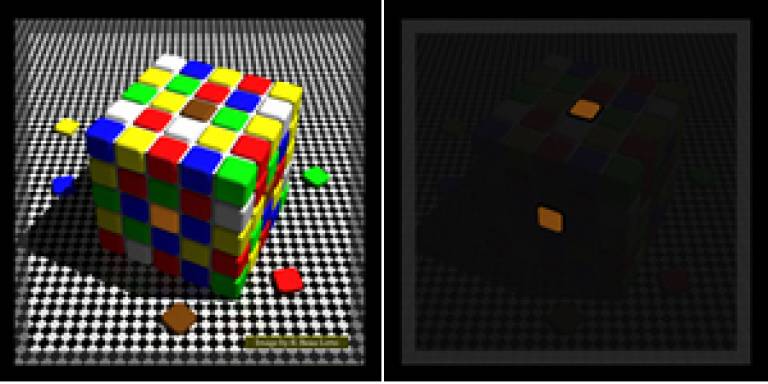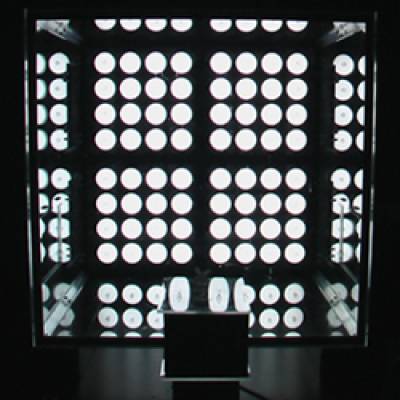Sight of the bumblebee
10 May 2005
Dr Beau Lotto and his team at UCL's Institute of Ophthalmology are interested in how our brain translates the huge amount of 'ambiguous' information that falls on our eyes into something 'meaningful'.
 He has
enlisted a cohort of bumblebees to help him in his quest and created a
flight arena, or 'Bee Matrix' complete with artificial flowers.
He has
enlisted a cohort of bumblebees to help him in his quest and created a
flight arena, or 'Bee Matrix' complete with artificial flowers.
Dr Lotto explained: "Playing chess is easy - we can programme a computer to do it at an advanced level. What's difficult is recognising the same object under an infinite number of environmental conditions. We perceive a world composed of differently coloured objects of various sizes, orientations, and locations in 3D space - this is extraordinary, since the necessary information to do this doesn't exist in the stimulus itself. The visual brain must somehow overcome this problem if it is to usefully generate responses towards the objects in the world, which it can only do by referring to information about what stimuli meant for visual behaviour in past experience."
Because our brains represent this historical information in its
circuitry, it can be tricked into seeing the same stimuli as completely
different in other circumstances. For example, the dark brown tile at
the centre of the top surface of the cube in depicted light is in fact
identical to the bright orange tile at the centre of the cube face.
Dr Lotto explains: "Of course, neither of these surfaces is in light or shadow. Rather the stimulus is only consistent with this experience, which is why we see it the way we do." Dr Lotto's challenge to understand vision lies in the relationship between the structure of the brain and the statistics of its ecological experience. All animals have evolved to successfully deal with the ambiguity of stimuli, and since the ecology, phylogeny and visual behaviour of the bumblebee is more tractable than it is for humans, Dr Lotto's team is hoping they will provide some answers to the fundamental principles that are common to all visual systems.

The matrix has been created to test their ability to recognise flower
colours under different colours of light. The matrix allows Dr Lotto
and his colleagues involved in the bee work, Dr Martina Wicklein and Mr
Richard Clarke, to completely control and manipulate the bee's
environment so that the behaviour and physiology of bees from different
environments can be compared under laboratory conditions.
The matrix is essentially a glass cube with an array of illuminated discs on one surface. The discs also have tubes in the centre that can be filled with nectar. Each disc can be altered in colour, so that a huge number of colour options and patterns can be created. When a bee is in the matrix, only one 'flower' type contains nectar, and the bee has to figure out which flower that is under a number of different circumstances of varying difficulty, set by the researchers.
Mr Clarke (Computer Science), an expert in artificial life simulations, has in fact re-created the Bee Matrix within the virtual world of computers. In this way, he can evolve virtual bees with artificial intelligence to adopt the same behavioural strategies that the real bees used to solve the same problems within an identical space. This will allow the researchers to examine the virtual bee's neural networks and compare it to the real bees, in order to determine both the computational principles by which such problems may be solve, and the quantity of visual behaviour that is due to nature versus nurture.
The team is looking to adapt the technology for visual applications in robots, as it assimilates the natural environment, which robots currently cannot do. They are also working on the possibility of translating visual information into soundscapes. This would create an audio language that can be learned by those with sight difficulties, enabling them to see through sound.
Dr Lotto will be taking the Bee Matrix to the Cheltenham Festival of Science from 8 to 12 June 2005 where he will be setting up interactive experiments to illustrate his research.
Images: Top - An example of how the same visual stimulus can appear very different. Bottom - The bee matrix.
To find out more use the links below.
 Close
Close

